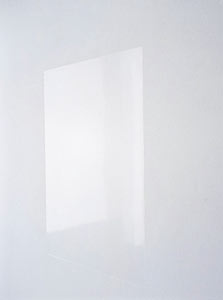
Born in 1957 in Bensberg (DE)
Lives and works in Stuttgart (DE)

1994
Wall piece
Mur peint poncé
50 x 70 cm
Year of Purchase: 1994
This wall piece is an art object with an unusual existence. On a wall covered with plaster and painted white a quadrangle is defined; the part of the wall thus delimited is then carefully sanded in such a way as to offer the eye a spotless surface, with no roughness at all, no grain, and capable of sending out reflections which contrast with the matt surface of the wall covering all around it. Through its rectangular form, its dimensions and its placing on the wall, this piece indisputably acts as a picture. Materially speaking, this picture does not result in the introduction of any element in the place where it is made. It comes by its status without having any recourse either to an exogenous surface or support – a canvas, for example – or any instrument of spatial delimitation with regard to the work – a frame, for example, or even to the application of a coat of paint. But if a picture of this sort adds nothing, it does not take away much of anything either. The process of removal it does enact actually turns out to be extremely limited, being summed up by just the paint powder created by the sanding operation. Not distinguishable, by means of relief or colour, from the wall area where it is placed, the pictorial field has just a single determining factor: the sensitivity of the surface offered to the action of light. This is thus an unusual picture, which only lends itself as such to the gaze because it offers a shiny surface, reflecting light more than its immediate mural surroundings. The reflection here is the only component part of the picture.
Such a restricted material definition of the work can certainly only tally with a visual presence devoid of any emphasis. In fact, a piece such as this is so discreet that it is possible to imagine that a viewer in a hurry might not even notice this area of four-sided shininess, and wonder where the expected artwork might be found. Put another way, when it comes to the crunch, the artwork, be it material or statuary, of non-existence, sees its perception subject to one condition: the spectator’s attention. Given the participation of the spectator, we find a second condition to do with light. The mere availability of the spectator is nevertheless not enough to get this kind of piece to work fully. It is also important that the lighting is suitable for the glorification of the reflective capacities of the polished surface, and that the spectator be able to position himself in relation to the light source. With the twofold involvement of spectator and light, it is in fact these two a priori conditions for the existence of a visual art which are raised.
But why, then, dispense the reflections in this way? In order to contextualize the art object. Okay, but why dispense such precarious reflections? In order to preserve a certain degree of intransitivity, so that the spectator will retain the reflection more than the object reflected, so that the ‘picture’ manages to remain a surface that is sensitive to its context rather than assert itself as a mere surface of images in this context. At a figural level, the reflections dispensed are, in this way, rather deceptive; on the other hand, they are sufficient as a result of the lighting conditions, the degree of attentiveness from the spectator, and the positioning of this latter which they – the reflections – require, in order, in a timely way, to invite the spectator not to forget that the work of art cannot be regarded as autonomous, and independent of the context of its presentation.
Michel Gauthier